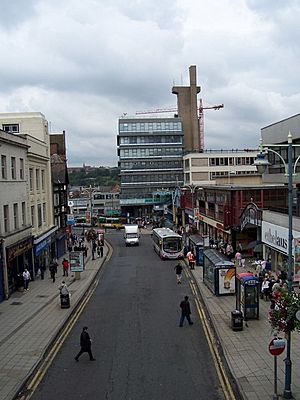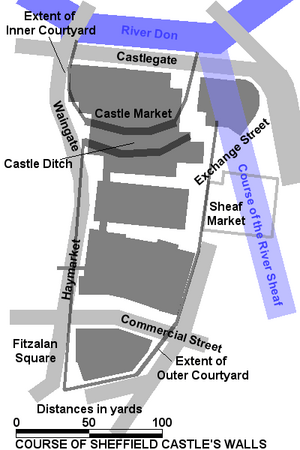Sheffield Castle facts for kids
Sheffield Castle was an important castle in Sheffield, England. It was built where two rivers, the River Sheaf and the River Don, meet. This spot might have been home to an Anglo-Saxon building even before the castle.
The first castle was a motte and bailey type, made of wood and earth. It was built sometime after the Normans took over England in 1066. This first castle was later destroyed during a big fight called the Second Barons' War.
A new, stronger castle made of stone was started four years later in 1270. This is the castle most people think of. Mary, Queen of Scots, was held prisoner here for 14 years between 1570 and 1584. During the English Civil War, the castle was used by the King's forces. But in 1644, after a short fight, it was taken by the Parliamentarians. They ordered the castle to be torn down, and it was.
Today, there are no known pictures or plans of the castle from when it was standing. However, digs in the 1920s found stone foundations from the 1270 castle. They also found signs of even older buildings beneath it.
Contents
Where Was Sheffield Castle?
Sheffield Castle was built where the River Sheaf and the River Don join. It was on the west side of the Sheaf and the south side of the Don. The rivers helped protect the castle on its north and east sides. On the south and west, there was a moat (a deep ditch, often filled with water).
This area was mostly covered by the Castle Market building, which was taken down in 2015.
People lived in this area a very long time ago. Archaeologists have found old items like a Bronze Age flint tool and Roman pottery. This shows that the site was important for early settlements in Sheffield.
The First Castle: William de Lovetot's Castle
The first castle in Sheffield after the Norman invasion was likely built by William de Lovetot. He was an Anglo-Norman noble who became the lord of the area around Sheffield in the early 1100s. The first mention of a castle in Sheffield dates back to around 1188.
This early castle was probably a wooden motte and bailey castle. This type of castle had a large mound (motte) with a tower on top, and a walled courtyard (bailey) below.
Later, the castle and town became part of the Furnival family's lands. In 1266, during the Second Barons' War, a group of rebels attacked Sheffield. They burned down the church and the castle.
The Stone Castle: Thomas de Furnival's Castle
After the first castle was destroyed, Thomas de Furnival got permission from King Henry III in 1270 to build a new one. This time, it was made of strong stone.
This stone castle was quite large. It stretched from the River Sheaf to Waingate and from the River Don to Dixon Lane. It covered an area of about 4.2 acres (17,000 square meters). There was also a huge park connected to the castle, covering about 2,461 acres (10 square kilometers). In 1516, George Talbot, 4th Earl of Shrewsbury, built another large house called Sheffield Manor in this park.
On February 24, 1574, an earthquake hit Sheffield. It damaged the part of the castle where Mary, Queen of Scots was being held prisoner.
Thomas de Furnival died soon after his castle was finished. He was buried inside the castle. A report from 1707 said that when the castle was torn down, a stone was found with an inscription that read: "I Lord Furnival; I built this castle-hall; And under this wall; Within this tomb was my burial."
The Castle During the English Civil War
As England moved towards civil war, Sheffield Castle became very important. On October 11, 1642, Sir John Gell took control of the town and castle for the Parliamentarians (those who supported Parliament).
However, in April 1643, the Royalist forces (those who supported the King) arrived in Yorkshire. The Parliamentarian defenders in Sheffield fled, and the Royalists took the castle without a fight. The Royalists left a group of soldiers to guard the castle.
In August 1644, the Parliamentarians, led by Major-General Crawford, came back with 1,200 soldiers to take Sheffield. At first, the castle was strong, and the Parliamentarians' cannons weren't powerful enough to break its walls. They asked for bigger cannons, including a very large one called "the Queen's pocket-pistoll."
Once these powerful cannons arrived, they were able to break through the castle wall. After this, both sides agreed to terms for the castle to surrender.
Here are some of the main points of the agreement for the castle's surrender:
- The castle, with all its weapons and supplies, was to be given to the Parliamentarians.
- The Governor and officers could leave with their horses, swords, and pistols. They could go to another Royalist castle or wherever they wanted, with a safe escort.
- The common soldiers could go home or wherever they pleased.
- Officers and soldiers could take their families and their own belongings with them.
- Lady Savile, the widow of the Royalist commander, could leave with her family and goods to Thornhill or elsewhere, with a guard. She was pregnant at the time.
- Gentlemen in the castle who were not soldiers could leave with their horses, swords, and pistols. They could live in their own homes if they followed Parliament's rules.
- Everyone leaving could have a week to move their belongings from the castle.
After the castle was taken, Colonel John Bright became its governor. Later, Captain Edward Gill took charge. On July 13, 1647, Parliament decided that Sheffield Castle should be torn down.
Even though much of the castle was destroyed, in 1649, the Earl of Arundel bought it back, hoping to rebuild it. But the damage was too great, and no repairs were ever started. The castle was completely leveled. For a while, the land was used as an orchard, then a bowling green, before buildings were constructed over it.
Finding the Castle's Remains

In 1927, an excavation led by Leslie Armstrong found the base of one of the castle's gate towers and part of the gateway. These parts of the castle were kept safe under the city's Castle Market building. They are now a Grade II listed site, meaning they are historically important. You could visit them by booking a tour.
The visible remains were in two rooms beneath the now-demolished Castle Market. They are the ruins of one of the gate towers, about 32 feet (9.7 meters) above the River Don. They show about a quarter of the eastern tower.
More recent excavations in 1999 and 2001 showed that the castle was much bigger than people had thought. It was one of the largest medieval castles in England. Markers have been placed on the ground to show where the castle's boundaries were.
A group called "Friends of Sheffield Castle" works to research and promote the castle's remains. In 2017, money was given to improve the Castlegate area of Sheffield, including a big archaeological dig in 2018. A virtual reality model of the castle was also created by the University of Sheffield.
See also
 In Spanish: Castillo de Sheffield para niños
In Spanish: Castillo de Sheffield para niños


